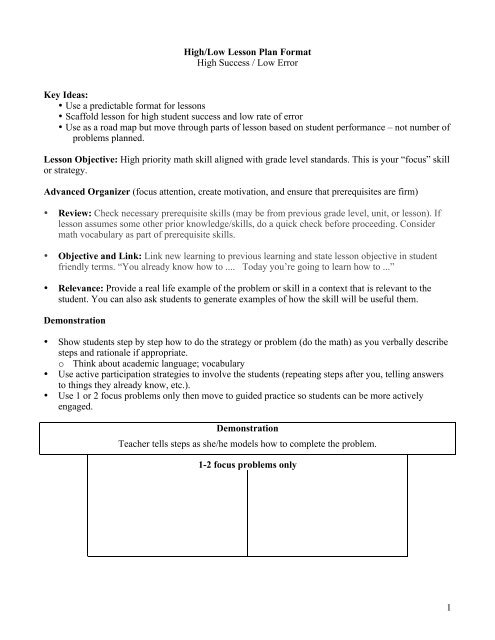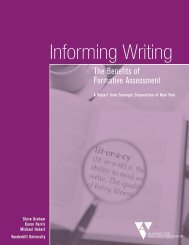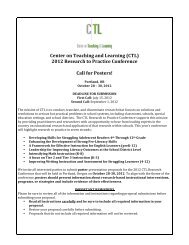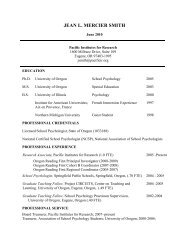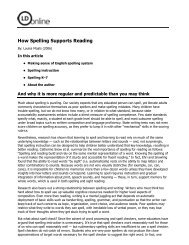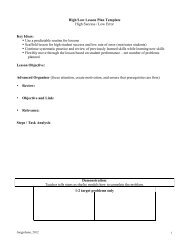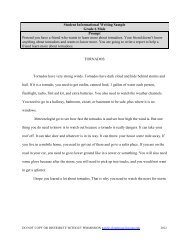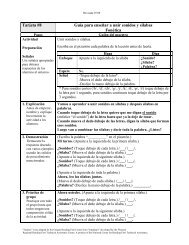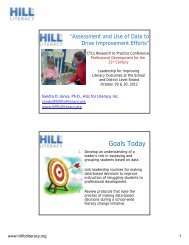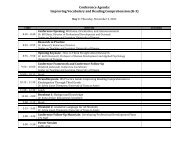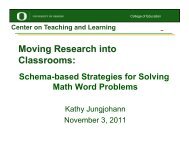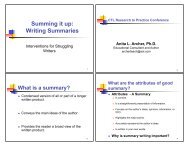High/Low Lesson Plan Template
High/Low Lesson Plan Template
High/Low Lesson Plan Template
- No tags were found...
You also want an ePaper? Increase the reach of your titles
YUMPU automatically turns print PDFs into web optimized ePapers that Google loves.
<strong>High</strong>/<strong>Low</strong> <strong>Lesson</strong> <strong>Plan</strong> Format<strong>High</strong> Success / <strong>Low</strong> ErrorKey Ideas:• Use a predictable format for lessons• Scaffold lesson for high student success and low rate of error• Use as a road map but move through parts of lesson based on student performance – not number ofproblems planned.<strong>Lesson</strong> Objective: <strong>High</strong> priority math skill aligned with grade level standards. This is your “focus” skillor strategy.Advanced Organizer (focus attention, create motivation, and ensure that prerequisites are firm)• Review: Check necessary prerequisite skills (may be from previous grade level, unit, or lesson). Iflesson assumes some other prior knowledge/skills, do a quick check before proceeding. Considermath vocabulary as part of prerequisite skills.• Objective and Link: Link new learning to previous learning and state lesson objective in studentfriendly terms. “You already know how to .... Today you’re going to learn how to ...”• Relevance: Provide a real life example of the problem or skill in a context that is relevant to thestudent. You can also ask students to generate examples of how the skill will be useful them.Demonstration• Show students step by step how to do the strategy or problem (do the math) as you verbally describesteps and rationale if appropriate.o Think about academic language; vocabulary• Use active participation strategies to involve the students (repeating steps after you, telling answersto things they already know, etc.).• Use 1 or 2 focus problems only then move to guided practice so students can be more activelyengaged.DemonstrationTeacher tells steps as she/he models how to complete the problem.1-2 focus problems only1
Guided Practice - highly structured teacher directed• Teacher and students do examples together with teacher verbally guiding students through each stepas students carry out the steps of the problem. Teacher monitors closely so students do all partscorrectly.• 2-3 focus problems should be sufficient.Guided Practice – <strong>High</strong> StructureTeacher tells steps as students complete problems.2-3 focus problems onlyGuided Practice -medium structure student directed• Students tell steps or strategy or explain what to do next.o Teacher may need to use sentence frames.• Begin with teacher prompts and scaffold until students can tell teacher or a partner how to do thesteps (and why).• Use focus problems only.• Do until students can successfully tell steps of the strategy.Guided Practice – Medium StructureStudents tell the steps for completing the problems3-5 focus problems only2
Guided Practice-low structure• Use focus problems AND add in discrimination and/or review problems (1/2 to 1/3 discrimination orreview).• Have students look at each problem and determine if they will use the new strategy or a differentstrategy.o Student completes problem – gets teacher feedback – does the next problem, etc.• Continue prompting and monitoring until students can successfully alternate completing focus anddiscrimination/review problems and are ready for independent work.• How you will determine if students are ready to move on to independent practice?• How you will differentiate for students who are not ready to move on?Guided Practice – <strong>Low</strong> StructureStudents complete problem at a time, telling whether to use the new strategyFocus problemsDiscrimination and review problemsIndependent Practice• Students practice the new skill/strategy for fluency, accuracy, and retention while the teachermonitors so students do not practice errors.• Once a skill moves to independent practice, discrimination and review problems should always beincluded for maintenance of previously learned skills.• Only after students complete independent practice problems successfully in group/class – can theseproblems can go home for homework.Independent Practice (8-15 problems)Students complete mix of focus (1/2), and discrimination and review problems (1/2) on their own withteacher monitoring3


